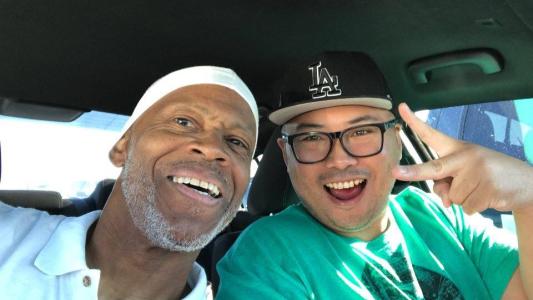Dr. Gary Slutkin is an epidemiologist and founder of Cure Violence, an organization dedicated to reducing violence around the world by treating it as a public health problem. After spending 10 years fighting epidemics abroad, Dr. Slutkin returned to Chicago to find his hometown in the middle of a different kind of epidemic: violence. By applying the lessons and skills he learned as an epidemiologist, Dr. Slutkin and his Cure Violence team take a public health approach to violence reduction that has seen remarkable results around the world. The program is being replicated all across the US and in more than 50 communities globally.
Freethink spoke with Dr. Slutkin about the need to think about violence as a disease and public health problem as opposed to a law enforcement problem.
This interview has been edited and condensed for clarity.
Freethink: What motivated you to want to go from being a medical doctor in rural environments to now working with violence in urban settings?
Dr. Gary Slutkin: I just came back home in the late 90s, after 10 years abroad, and I needed a break. I moved home to Chicago. That’s when I began to notice all these situations of violence. I didn’t know that America was having this problem with violence. I began to ask questions as to what people were doing about it. And then very shortly I began to see that this was a problem very similar (to what I was working on overseas). In other words, it looked just like an infectious disease. But it was not being managed in what I thought would be the right way.
Freethink: How is violence like an infectious disease?
Slutkin: It’s contagious. One event leads to another. I got to understand it in that way by looking at curves and graphs and maps. The curves look exactly like any other epidemic curve – how much violence there is over time and how it grows and comes down and goes up again. That’s just like a Cholera curve. And the maps are similar too. They have these clusterings of an epicenter or a hot spot. It looks like an AIDS hot spot or a Cholera hot spot – it’s a violence hot spot.
Freethink: How are epidemic diseases managed?
Slutkin: Invisibly. The way that epidemics are managed is always from the inside out. It’s kind of invisible to the public. In other words, there are health workers who are recruited and selected from the neighborhoods themselves. They are trained to determine where the next event might happen. If it’s Ebola then it’s the next Ebola event. In this case, it’s about looking for the next violent event. You have health workers – we call them violence interrupters – who are looking for where someone might be upset or might be planning something. And these interrupters are people from the same neighborhood because that’s required for the credibility and the trust so that they can interact with the person. They’re trained to be able to shift that person’s perspective as well as cool down their emotions.
They also interact with their friends. So if there had already been, let’s say, an event of tuberculosis or measles, you’d have to then look to see who might get measles next and immunize the person. That’s how violent events don’t happen, people are immunized. What happened to bird flu? What happened to measles? People are immunized.
Freethink: Does this way of thinking about violence change how we approach it at a societal level?
Slutkin: It changes everything. It completely turns the whole world upside down. Now we can see why we have not succeeded. Now we can apply the same kinds of methods that public health does (to diseases like cholera and TB) and see how it can move into being a thing of the past just as these other diseases have moved into the past. We don’t say, “Here’s the tuberculosis patient. We caught him.” We look at it as we’re just trying to help that person not progress to a full problem. It also allows us to understand the person other than it being, “Oh these are bad people who do it” which is what we thought about people who had leprosy or plague.
Freethink: How does this approach compare to the approach we are currently taking with violence?
Slutkin: The approach that’s more commonly taken today is medieval. It will be looked at in the future the way that we now look at when we put people with diseases into dungeons or thought that they were evil. Now we understand germ theory and we apply various behavioral approaches whether it’s getting rid of mosquitoes or doing hand washing and improving sanitation. All the things we do now in public health. So it shifts us from morality to science.
The Institute of Medicine and the National Research Council, so many researchers with so much data have shown that health methods are what works.
Freethink: Some critics might say that treating violence as a disease is eroding responsibility because people don’t choose to have a disease but people could choose to react with violence. How do you respond to that?
Slutkin: What people think are choices are really a little more unconscious and a little less thought through than people would like to believe. Most of the reasons why people do things are that they think their friends expect them to do it and they’re not really thinking about the consequences. There’s an exaggerated idea that people are rationally making decisions. It’s more that we follow. We’re creatures of following, which is what contagion is. It’s unconscious and that’s why the health workers, the violence interrupters, help people to stop what they are doing.
Freethink: What would you say to a young person whose thinking about committing harm?
Slutkin: It’s very critical to start by cooling down and buying time. Interrupters let someone complain that his brother or someone insulted him or slept with his girlfriend or owes him money or whatever. They let the person vent without judgment. They let them know that they get it. And then with that time, that interrupter gradually begins to understand the situation and what it needs. It might be that someone gets paid back. It might be that someone needs to be respected. Or maybe there’s a misunderstanding of the situation and someone didn’t mean it. Maybe they need a different perspective.
Freethink: How do you know if this strategy is working?
Slutkin: Cure Violence measures its success by how much and how quickly shootings and killings in a neighborhood go down. And this work is extremely dependent on data. You have to see that the number of shootings is going down from month to month. And it does happen fast so we watch that. Additionally, we repeatedly have independent evaluators from the Justice Department, the CDC, Johns Hopkins, many others.
I would say that one of the most successful applications of Cure Violence is really in New York City which is keeping its violence down. The city and the state and philanthropy groups have invested very heavily since 2009. And they’ve had two very strong evaluations done of their work.
Freethink: Cure Violence is global. How do you adapt the strategy to different local cultures?
Slutkin: We work with the usual gang and street violence in Latin America. Sometimes with cartels. We work with militias and tribes. We’ve worked in the middle east on election violence in Kenya. We’ve worked on the violence in prisons in the UK.
There are all kinds of applications but the principles are the same. You end up having health workers who need to be trained. The health workers need to come from the same groups in order to have access and credibility and trust. It’s kind of like tuberculosis control or cholera control or AIDS. There are ways that it needs to be adapted to what’s going on locally, but there’s a general set of principles and guiding methods that you have to be able to adapt.
Freethink: What do the violence interrupters have to go through to get qualified?
Slutkin: They do over 100 hours of initial training and then there’s on-going training. It starts with re-understanding the problem as a contagious health problem. You have to unravel and release other thoughts. After that, it’s the nuts and bolts of how to let people know that this is who you are – a violence interrupter that people can call to diffuse situations. That stuff, cooling down and changing perspectives, is really trained through a lot of skills application. It’s role-playing and practice. Younger workers go out with more experienced workers to see how they do it.
Freethink: What’s been the most surprising thing that this work has taught you about violence?
Slutkin: I was surprised to learn how powerful the influence of others is on your brain, how much we invisibly copy each other and do what we think others expect of us. This is so powerful. It’s as powerful as the bacteria that makes you cough. This is a kind of a revelation itself.
Freethink: How does violence affect the brain?
Slutkin: We have determined that there are four brain locations that have responsibilities for copying and causing people to follow each other and to overreact. If you go to our website you can find the article on the Institute of Medicine that I wrote about violence like a contagious disease. There’s a couple of pages there on the brain science of violence. In essence, there are nerve cells that copy. And that’s what you see in little kids when you stick out your tongue and they stick out their tongue or you make a face and they make the face. So there’s copying neurons. And that’s very advantageous for a lot of behaviors.
Then there’s your dopamine pathway causes you to want to get the approval of your peers for status or recognition – and pain pathways that keep you from going outside of that path; or in other words, to avoid the disapproval or the expected disapproval of friends. So you’re afraid to not do what they might expect.
These three: copying, dopamine, and pain pathways keep you away from friend disapproval. Lastly, the effect of having been traumatized causes you to overreact. These are primarily the ways in which the brain does processing of exposure to violence to cause the person to be more likely to do violence. Similar to someone who gets the flu and the flu bug is processed in the respiratory tract and then you cough out more of it. Or the intestines takes in Cholera and then produces more of it. Your brain is doing the same thing with respect to violence. Processing and then producing more of it.
Freethink: Was there anything else that shocked or surprised you?
Slutkin: I was surprised to see when we first tried this in the year 2000 in what was the worst placed district in the country at the time how fast we saw a decline in violence. This was just our first try. We got a 67 percent drop in shootings and killings in the first year. And most of the result happened in the first month and a half. I was surprised at how fast and how powerful it worked.
And I’ve also been surprised at how slow the uptake of this method has been. When we are developing new strategies for AIDS or for Malaria communities are so eager to have something new to try. There’s a little more tendency in America to be stuck on what we’ve been doing. And just keep trying it over and over and over.
Freethink: Do you have any thoughts as to why we’ve been so reluctant to change how we deal with violence in the US?
Slutkin: Well I think there’s still an overriding idea that we haven’t developed the new frame yet of violence as a health issue. There’s also a lack of understanding of public health methods. I think we’re just stuck in the old thoughts. It’s a worldview change.






